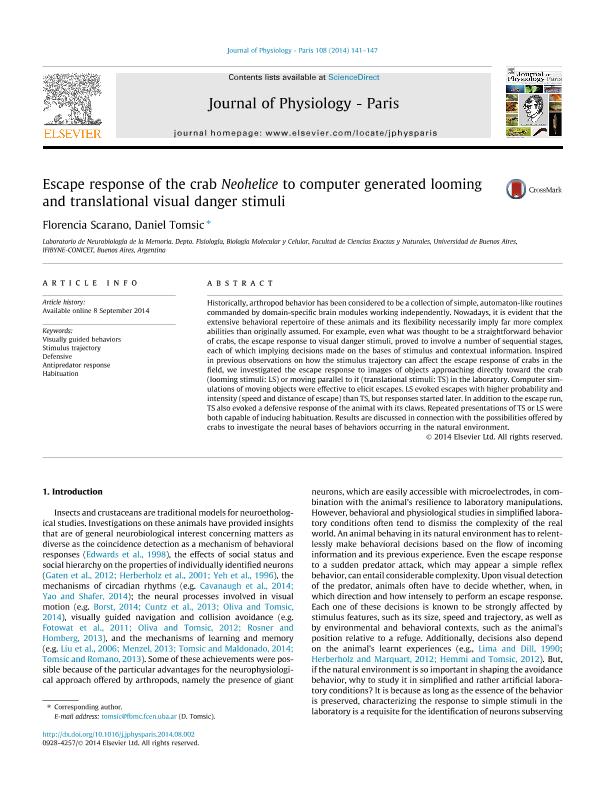Mostrar el registro sencillo del ítem
dc.contributor.author
Scarano, María Florencia

dc.contributor.author
Tomsic, Daniel

dc.date.available
2017-07-11T15:39:49Z
dc.date.issued
2014-06
dc.identifier.citation
Scarano, María Florencia; Tomsic, Daniel; Escape response of the crab Neohelice to computer generated looming and translational visual danger stimuli; Elsevier; Journal of Physiology; 108; 2-3; 6-2014; 141-147
dc.identifier.issn
0928-4257
dc.identifier.uri
http://hdl.handle.net/11336/20101
dc.description.abstract
.Historically, arthropod behavior has been considered to be a collection of simple, automaton-like routines commanded by domain-specific brain modules working independently. Nowadays, it is evident that the extensive behavioral repertoire of these animals and its flexibility necessarily imply far more complex abilities than originally assumed. For example, even what was thought to be a straightforward behavior of crabs, the escape response to visual danger stimuli, proved to involve a number of sequential stages, each of which implying decisions made on the bases of stimulus and contextual information. Inspired in previous observations on how the stimulus trajectory can affect the escape response of crabs in the field, we investigated the escape response to images of objects approaching directly toward the crab (looming stimuli: LS) or moving parallel to it (translational stimuli: TS) in the laboratory. Computer simulations of moving objects were effective to elicit escapes. LS evoked escapes with higher probability and intensity (speed and distance of escape) than TS, but responses started later. In addition to the escape run, TS also evoked a defensive response of the animal with its claws. Repeated presentations of TS or LS were both capable of inducing habituation. Results are discussed in connection with the possibilities offered by crabs to investigate the neural bases of behaviors occurring in the natural environment.
dc.format
application/pdf
dc.language.iso
eng
dc.publisher
Elsevier

dc.rights
info:eu-repo/semantics/openAccess
dc.rights.uri
https://creativecommons.org/licenses/by-nc-nd/2.5/ar/
dc.subject
Escape Response
dc.subject
Visual Behaviors
dc.subject
Looming Stimuli
dc.subject
Crabs
dc.subject.classification
Otras Ciencias Biológicas

dc.subject.classification
Ciencias Biológicas

dc.subject.classification
CIENCIAS NATURALES Y EXACTAS

dc.title
Escape response of the crab Neohelice to computer generated looming and translational visual danger stimuli
dc.type
info:eu-repo/semantics/article
dc.type
info:ar-repo/semantics/artículo
dc.type
info:eu-repo/semantics/publishedVersion
dc.date.updated
2017-07-11T13:25:46Z
dc.journal.volume
108
dc.journal.number
2-3
dc.journal.pagination
141-147
dc.journal.pais
Países Bajos

dc.journal.ciudad
Amsterdam
dc.description.fil
Fil: Scarano, María Florencia. Consejo Nacional de Investigaciones Científicas y Técnicas. Oficina de Coordinación Administrativa Ciudad Universitaria. Instituto de Fisiología, Biología Molecular y Neurociencias. Universidad de Buenos Aires. Facultad de Ciencias Exactas y Naturales. Instituto de Fisiología, Biología Molecular y Neurociencias; Argentina
dc.description.fil
Fil: Tomsic, Daniel. Consejo Nacional de Investigaciones Científicas y Técnicas. Oficina de Coordinación Administrativa Ciudad Universitaria. Instituto de Fisiología, Biología Molecular y Neurociencias. Universidad de Buenos Aires. Facultad de Ciencias Exactas y Naturales. Instituto de Fisiología, Biología Molecular y Neurociencias; Argentina
dc.journal.title
Journal of Physiology

dc.relation.alternativeid
info:eu-repo/semantics/altIdentifier/doi/http://dx.doi.org/10.1016/j.jphysparis.2014.08.002
dc.relation.alternativeid
info:eu-repo/semantics/altIdentifier/url/http://www.sciencedirect.com/science/article/pii/S0928425714000369
Archivos asociados
